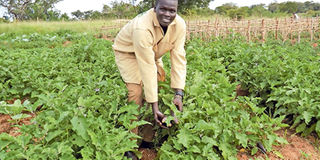Firm finds ‘gold’ in sisal waste

Kilifi Plantation Ltd farm manager Francis Lorot Emurai in the farm. According to him, to get manure from sisal, it has to be extracted from the leaves and the waste passed through clean water. PHOTO | BOZO JENJE | NMG
What you need to know:
- Emurai says the agribusiness venture is part of diversification. Previously the farm only focused on livestock and sisal.
- The farm has a 200,000-litre dam that comes in handy during the dry season. Sunken beds were made for the crops planted in rows. Before transplanting the seedlings, the waste is applied in the bed.
- The farm relies on three permanent workers but also hires casuals when the need arises. One of the challenges facing horticulture in Kilifi is high temperatures.
- Dr Hemedi Saha Mkuzi, a crop expert, says soil should be analysed before planting.
After an overnight downpour, we cruise across the green Vipingo sisal plantation on the Malindi road, heading to Msumarini to witness an integrated horticultural and apiary project.
On the 11-acre farm, workers are harvesting tomatoes and spinach while others are tilling in readiness for planting. Near the yellow passion orchards is a heap of sisal waste manure.
Kilifi Plantation Ltd farm manager Francis Lorot Emurai ushers us into a three-acre section with crops at various stages of growth. Emurai says the agribusiness venture is part of diversification. Previously the farm only focused on livestock and sisal.
The 27-year-old says using sisal waste fertiliser to grow vegetables and fruits started in November 2018.
“We had used the waste as organic fertiliser on flower beds and trees and realised it could be tried on other crops,” he said.
The Range Management graduate says to get manure from sisal, it has to be extracted from the leaves and the waste made to pass through clean water. “The waste is then dumped into a lagoon and left to rot for 10 years,” he said.
The farm has a 200,000-litre dam that comes in handy during the dry season. Sunken beds were made for the crops planted in rows. Before transplanting the seedlings, the waste is applied in the bed.
“We get soil samples for analysis and are often advised on the type of fertiliser to use in order to complement the sisal waste,” he says.
SOIL SHOULD BE TESTED BEFOREHAND
The farm started with an investment of sh130,000. The crops grown include yellow passion, brinjals, sweet potatoes, spinach, kales, tomatoes, amaranth and black shades.
The farm relies on three permanent workers but also hires casuals when the need arises. One of the challenges facing horticulture in Kilifi is high temperatures.
“We water the plants, but it does not take long before they start withering,” he said. “Mulching is important because our soils are sandy.”
Boiled neem leaf liquid is used to control tomato blight. The farm has 320 langstroth hives on neem and baobab trees.
“We realised that to get more yields, we needed pollinators. The bees also give us honey,” Emurai said.
Some 200 kilogrammes of honey has been harvested in the past five months. The hives are managed by African Bee Hives. The agency gives an agreed percentage of the profit from honey to Kilifi Plantation Ltd farm.
Many greengrocers in Kilifi get their stock from the farm. In the past six months, the farm has made about Sh180,000 from vegetables alone. He believes the coming of the short rains in October and November will improve harvests.
A bunch of brinjals and spinach goes for Sh50, sukuma wiki (Sh60), a kilogramme of tomatoes (Sh60), yellow passion (Sh120) and a kilo of night shade (Sh65).
Dr Hemedi Saha Mkuzi, a crop expert, says soil should be analysed before planting.
“Most farmers do not replenish their soil after harvest, diminishing their subsequent yields,” the Pwani University don said.




